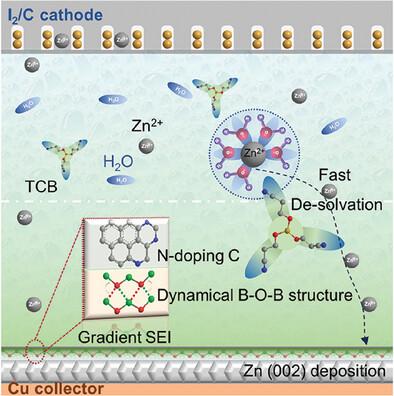当前位置:
X-MOL 学术
›
Adv. Mater.
›
论文详情
Our official English website, www.x-mol.net, welcomes your
feedback! (Note: you will need to create a separate account there.)
Crystallographic Reorientation Induced by Gradient Solid‐Electrolyte Interphase for Highly Stable Zinc Anode
Advanced Materials ( IF 27.4 ) Pub Date : 2024-11-16 , DOI: 10.1002/adma.202412667 Ming Zhao, Yanqun Lv, Jun Qi, Yong Zhang, Yadong Du, Qi Yang, Yunkai Xu, Jieshan Qiu, Jun Lu, Shimou Chen
Advanced Materials ( IF 27.4 ) Pub Date : 2024-11-16 , DOI: 10.1002/adma.202412667 Ming Zhao, Yanqun Lv, Jun Qi, Yong Zhang, Yadong Du, Qi Yang, Yunkai Xu, Jieshan Qiu, Jun Lu, Shimou Chen

|
Oriented zinc (Zn) electrodeposition is critical for the long‐term performance of aqueous Zn metal batteries. However, the intricate interfacial reactions between the Zn anode and electrolytes hinder a comprehensive understanding of Zn metal deposition. Here, the reaction pathways of Zn deposition and report the preferential formation of Zn single‐crystalline nuclei followed by dense Zn(002) deposition is elucidated, which is induced by a gradient solid‐electrolyte interphase (SEI). The gradient SEI composed of abundant B‐O and C species facilitates faster Zn2+ nucleation rate and smaller nucleus size, promoting the formation of Zn single‐crystalline nuclei. Additionally, the homogeneity and mechanical stability of SEI ensure the crystallographic reorientation of Zn anodes from Zn(101) to (002) planes, efficiently inhibiting dendrite growth and metal corrosion during the Zn2+ stripping/plating process. These advantages significantly enhance the stability of the Zn anode, as demonstrated by the prolonged cycling lifespan of symmetric Zn batteries and exceptional reversibility (>99.5%) over 5000 cycles in Zn//Cu asymmetric batteries. Notably, this strategy also enables the stable operation of anode‐free Zn//I2 batteries with a long lifespan of 3000 cycles. This work advances the understanding of Zn electrochemical behaviors, encompassing Zn nucleation, growth, and Zn2+ stripping/plating.
中文翻译:

梯度固-电解质界面诱导的晶体学取向,实现高度稳定的锌负极
取向锌 (Zn) 电沉积对于水性 Zn 金属电池的长期性能至关重要。然而,Zn 阳极和电解质之间错综复杂的界面反应阻碍了对 Zn 金属沉积的全面理解。在这里,阐明了 Zn 沉积的反应途径,并报告了 Zn 单晶核的优先形成,然后是致密的 Zn(002) 沉积,这是由梯度固体电解质界面 (SEI) 诱导的。由丰富的 B-O 和 C 物质组成的梯度 SEI 有助于更快的 Zn2+ 成核速率和更小的原子核尺寸,促进 Zn 单晶核的形成。此外,SEI 的均匀性和机械稳定性确保了 Zn 阳极的晶体学从 Zn(101) 平面重新取向 (002) 平面,有效抑制了 Zn2+ 剥离/电镀过程中的枝晶生长和金属腐蚀。这些优点显着提高了 Zn 负极的稳定性,对称 Zn 电池的循环寿命延长和 Zn//Cu 不对称电池在 5000 次循环中出色的可逆性 (>99.5%) 就证明了这一点。值得注意的是,这种策略还使无阳极 Zn//I2 电池能够稳定运行,使用寿命长达 3000 次循环。这项工作促进了对 Zn 电化学行为的理解,包括 Zn 成核、生长和 Zn2+ 剥离/电镀。
更新日期:2024-11-16
中文翻译:

梯度固-电解质界面诱导的晶体学取向,实现高度稳定的锌负极
取向锌 (Zn) 电沉积对于水性 Zn 金属电池的长期性能至关重要。然而,Zn 阳极和电解质之间错综复杂的界面反应阻碍了对 Zn 金属沉积的全面理解。在这里,阐明了 Zn 沉积的反应途径,并报告了 Zn 单晶核的优先形成,然后是致密的 Zn(002) 沉积,这是由梯度固体电解质界面 (SEI) 诱导的。由丰富的 B-O 和 C 物质组成的梯度 SEI 有助于更快的 Zn2+ 成核速率和更小的原子核尺寸,促进 Zn 单晶核的形成。此外,SEI 的均匀性和机械稳定性确保了 Zn 阳极的晶体学从 Zn(101) 平面重新取向 (002) 平面,有效抑制了 Zn2+ 剥离/电镀过程中的枝晶生长和金属腐蚀。这些优点显着提高了 Zn 负极的稳定性,对称 Zn 电池的循环寿命延长和 Zn//Cu 不对称电池在 5000 次循环中出色的可逆性 (>99.5%) 就证明了这一点。值得注意的是,这种策略还使无阳极 Zn//I2 电池能够稳定运行,使用寿命长达 3000 次循环。这项工作促进了对 Zn 电化学行为的理解,包括 Zn 成核、生长和 Zn2+ 剥离/电镀。


















































 京公网安备 11010802027423号
京公网安备 11010802027423号